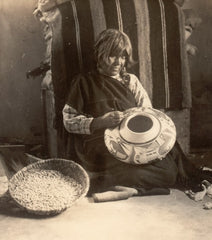Artist: Nampeyo (Num-pa-yu, translates to: snake that does not bite) April 07 2016
 Most people who collect Hopi Pottery have heard the name: Nampeyo. This week we will talk about her life and in the weeks to follow we will talk more about her inspiration, technique and design aesthetic.
Most people who collect Hopi Pottery have heard the name: Nampeyo. This week we will talk about her life and in the weeks to follow we will talk more about her inspiration, technique and design aesthetic.
Nampeyo, born around 1860, had a very traditional upbringing as a member of the Corn clan of the Tewa-Hopi tribe. As a child in the Tewa-Hopi community she would have been involved in all the day to day activates: collection of corn, gathering of water, cooking, and some sort of artisan work. In Nampeyo’s case it was the craft of pottery. In her youth, she began learning her craft from her mother, White Corn (although many sources state that she learned from her paternal Grandmother). She was taunted with the name “old lady” because she showed so much interest in the craft. Of course, when her talent for pottery became more apparent, this taunt became a term of endearment to those who knew her.
Her talent did not go unnoticed by outsiders. Her brother, Tom Polacca, was a tribal leader and interpreter. His line of work drew attention to the family, and more so Nampeyo. She was a young and attractive Native woman, who was very talented. Nampeyo and her craft were documented by well-known photographers like William Henry Jackson, Adam Clark Vroman, and Edward S. Curtis over the span of her 82-year life.
Nampeyo’s creativity continued through the prime of Hopi-Tewa pottery in the 1880s. Ethnographers and Anthropologists from all over the United States took notice of the Hopi-Tewa culture. Due to the isolation of the tribes-people, they were able to maintain their traditional lifestyle and cultural ceremonies. During this time tens of thousands of items were collected, and not the least of which was pottery. Nampeyo’s pottery was collected along with every other Hopi/Tewa woman potter, with little recognition. However from 1890-1900, she was one of two women potters register as still pursuing the craft as a career.
From 1890 to 1910, Nampeyo’s reputation grew and she quickly became one of the most a sought after Hopi potters. Nampeyo was invited to opening events and exhibts like the Hopi House opening, New Year’s Day 1905. She and her family stayed as Artists in resident for three months providing a bit of Native culture to the themed hotel. In the following years, she would make a second trip to the Hopi house, to yet again to be on display, creating her art. Nampeyo was later invited to Chicago for the 1910 United States Land and Irrigation Exposition to demonstrate her skills along side modern machinery.
However, as she aged trips like this appealed less and less. She might have been termed a homebody, but she had her family and friends that would come to enjoy her hospitality and excellent story telling, especially, the artists who came to Polacca to soak in the culture, like E. Irving Couse and his wife, Virginia, and Carl Oscar Borg.
During the rise and fall of the fad of owning Hopi material culture, Nampeyo became a shrewd businesswoman, knowing when to make additional pottery in preparation for the peak of the tourist season, during the Snake Dance ceremonies. She also knew her value as an artist, not allowing outsiders to dictate her prices. She was a cheerleader for her craft and invigorated the art of pottery in her community of Hano, First Mesa, Arizona until her death in 1942.
For further study, we recommend Nampeyo and Her Pottery by Barbara Kramer. Barbara Kramer includes an extensive Bibliography and was a source for this blog post.
Featured image: By Charles M. Wood, 1908-1910 [Public domain]
